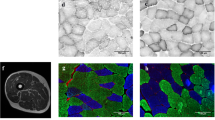Summary
The purpose of this study was to observe fiber area changes that might occur in the same subject from two opposing resistance-exercise training regimes isolating the quadriceps muscle group. Twelve college-age men divided into two groups participated in each of two 7.5-week regimens; one performed a muscular strength program (high-resistance, low-repetition) 4 days a week on a resistance-exercise apparatus, while the other performed a muscular endurance (low-resistance, high-repetition) program. After a 5.5-week hiatus, the groups changed regimens for the second 7.5 weeks. Closed-needle biopsies of the dominant vastus lateralis and isokinetic dynamometer evaluations were made before and at the end of each training period. The muscle samples were analyzed for area changes. In both groups the initial exercise stimulus, whether for strength or endurance, increased the area of fibers of all three major types (I, IIA, and IIB). Subjects doing strength exercises as their second treatment showed a further increase in the area of type I and IIB fibers, whereas those doing endurance exercises showed a decrease in all fiber types. From the first to the last biopsy all fiber areas were decreased (P<0.05) in the control-strength-endurance group and increased (P<0.05) in the control-endurance-strength group. These results suggested that endurance exercise preceding strength exercise in an isolated muscle group maximized fiber area adaptations to exercise stress. Consideration should thus be given in exercise and rehabilitation programs to the muscle cellular adaptations evidenced in different orders of training, particularly if muscular strength is considered important.
Similar content being viewed by others
References
Atha J (1981) Strengthening muscle. Exerc Sport Sci Rev 9:1–78
Bergström J (1962) Muscle electrolytes in man. Scand J Clin Lab Invest [Suppl 68]:1–110
Brooke MH, Kaiser KK (1970) Three myosin adenosine triphosphatase systems. The nature of their pH and sulfhydryl dependence. J Histochem Cytochem 18:670–672
Clarkson PM, Kroll W, McBride TC (1980) Maximal isometric strength and fiber type composition in power and endurance athletes. Eur J Appl Physiol 44:35–42
Costill DL (1967) The relationship between selected physiological variables and distance running performance. J Sports Med Phys Fitness 7:61–66
Dons B, Bollerup K, Bonde-Petersen F, Hancke S (1979) The effect of weight lifting exercise related to muscle fiber composition and muscle cross-sectional area in humans. Eur J Appl Physiol 49:95–106
Dubowitz V, Brooke MH (1973) Muscle biopsy: a modern approach. Saunders, Philadelphia, pp 20–72
Dudley GA, Djamil R (1985) Incompatibility of endurance and strength training modes of exercise. J Appl Physiol 59:1446–1451
Dudley GA, Fleck SJ (1987) Strength and endurance training. Are they mutually exclusive? Sports Med 4:79–85
Ferguson GA (1976) Statistical analysis in psychology and education. McGraw Hill, New York, pp 326–332
Gollnick PD, Armstrong RB, Saubert IV CW, Piehl K, Saltin B (1972) Enzyme activity and fiber composition in skeletal muscle of untrained and trained men. J Appl Physiol 33:312–319
Green HJ, Klug GA, Reichman H, Seedorf U, Wiehrer W, Pette D (1984) Exercise-induced fibre type transitions with regard to myosin, parvalbumin, and sarcoplasmic reticulum in muscles of the rat. Pflügers Arch 400:432–438
Hickson RC (1980) Interference of strength development by simultaneously training for strength and endurance. Eur J Appl Physiol 45:255–263
Hydrik L (1986) Strength and conditioning for Georgia Tech Basketball. Nat Str Cond Assoc J 8:48–53
Jackson CGR, Dickinson AW, Ringel SP (1983) Cellular muscle area alterations following two modes of resistance exercise training, in the same individual. Med Sci Sports Exerc 15:136
Jackson CGR, Sillau AH, Banchero N (1987) Fiber composition and capillarity in growing guinea pigs acclimated to cold and cold plus hypoxia. Proc Soc Exp Biol Med 185:101–106
MacDougall JD, Sale DG, Moroz JR, Elder GCB, Sutton JR, Howald H (1979) Mitochondrial volume density in human skeletal muscle following heavy resistance training. Med Sci Sports 11:164–166
MacDougall JD, Elder GCB, Sale DG, Moroz JR, Sutton JR (1980) Effects of strength training and immobilization on human muscle fibers. Eur J Appl Physiol 43:25–34
Ono M, Miya Shita M, Asami T (1976) Inhibitory effect of long distance running training on the vertical jump and other performances among aged males. In: Komi (ed) Biomechanics V-B. University Park Press, Baltimore, pp 94–100
Pauletto B (1985) Maximum off-season results through weight training and aerobic dance. Nat Str Cond Assoc J 7:56–57
Pette D, Vrbova G (1985) Neural control of phenotypic expression in mammalian muscle fibers. Muscle Nerve 8:676–689
Pollock M (1973) The quantification of endurance training programs. Exerc Sport Sci Rev 1:155–188
Saltin B, Gollnick FD (1983) Skeletal muscle adaptability: Significance for metabolism and performance. In: Peachey LD, Adrian RH, Geiger SR (eds) Handbook of physiology, section 10. Skeletal muscle. American Physiological Society, Bethesda, pp 555–631
Tesch PA, Karlsson J (1985) Muscle fiber types and size in trained and untrained muscles of elite athletes. J Appl Physiol 59:1716–1720
Tesch PA, Thorsson A, Kaiser P (1984) Muscle capillary supply and fiber type characteristics in weight and power lifters. J Appl Physiol Respir Environ Exerc Physiol 56:35–38
Wilmore JH, Parr RB, Girandola RN, Ward P, Vodak PA, Barstow JJ, Pipes TV, Romero GT, Leslie P (1978) Physiological alterations consequent to circuit weight training. Med Sci Sports 10:79–84
Author information
Authors and Affiliations
Rights and permissions
About this article
Cite this article
Ratzin Jackson, C.G., Dickinson, A.L. & Ringel, S.P. Skeletal muscle fiber area alterations in two opposing modes of resistance-exercise training in the same individual. Eur J Appl Physiol 61, 37–41 (1990). https://doi.org/10.1007/BF00236691
Accepted:
Issue Date:
DOI: https://doi.org/10.1007/BF00236691




